Joan Crawford's long road to Oscar
 Tuesday, March 9, 2021 at 11:45PM
Tuesday, March 9, 2021 at 11:45PM 
I make no secret that I'm a Joan Crawford fan. After all, I've already waxed poetic about the star's stellar 1947 and her turn in What Ever Happened to Baby Jane?. However, I've never written about Crawford's career pre-Oscar win. Since we're celebrating 75 years since that victory, it feels like an appropriate time to examine the actress' long road to Oscar, the misconceptions about her legacy, the complexities of her contemporary popularity. If you want to read more about the 18th Academy Awards, check out Baby Clyde's wonderful overview of the ceremony and the race for gold. Now, it's time to focus solely on that year's Best Actress champion…
Born in Texas as Lucille Le Sueur, the future Joan Crawford wasn't raised with a silver spoon in her mouth. She started working to earn money when she wasn't yet 10-years-old and her rise to Hollywood fame was by no means a tale of instant success. Starting her career as a chorus girl, Crawford first dreamed of dancing for a living, while acting was a vocation that came later when she was hired by MGM. At the time, any aspiring starlet had to contend with a studio focused on promoting other big names like Marion Davies and Norma Shearer. In 1925, Crawford even worked as Shearer's body double in Lady of the Night. In that flick, the First Lady of MGM played twins so Crawford was her stand-in, the unknown actress later obscured by the star in post-production.
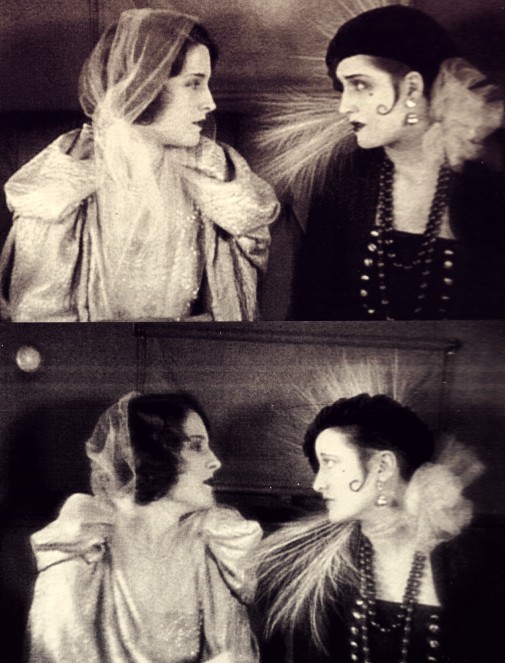 LADY OF THE NIGHT (1925)
LADY OF THE NIGHT (1925)
After years of playing bit parts and uncredited labor as an extra, Joan Crawford started getting some bigger roles as the era of the Silent Movie drew to a close. In 1927, she impressed many with her performance as the leading lady to Lon Chaney's armless criminal in the circus-set The Unknown. Seeing their contract player's newfound popularity, MGM was quick to capitalize and started working on making a new star out of her. In a couple of years, Joan Crawford went from an anonymous background actress to a star in progress. This newfound acclaim was solidified by her participation in several Billy Haynes star vehicles, college comedies that showcased a lighter side of Crawford's screen persona.
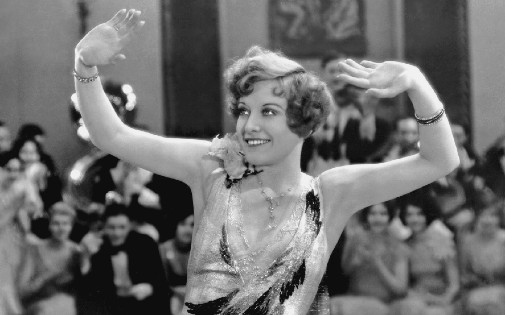 OUR DANCING DAUGHTERS (1928)
OUR DANCING DAUGHTERS (1928)
Nonetheless, if I were to pinpoint the moment Joan Crawford became a star, 1928's silent Our Dancing Daughters would be it. She transformed herself into the apex of the flapper archetype just as the 20s were coming to an end, a modern woman that electrified the screen with an image that viewers could relate to. Dancing furiously, smiling with pain glinting in her sad eyes, her spectacular characterization and feverish energy were admired by moviegoers all over. By the end of 1929, Crawford had made her last silent, Our Modern Maidens, let go of the flapper persona and embraced the talkies. This willingness to adapt was key to her success as well as its longevity. Hers was a career that spanned most of Hollywood's big studio era because, instead of fighting against the changing tide of culture, she went with it, transforming herself according to the demands of the moviegoing audience.
Her early approach to professional life may have been marked by stoic acquiescence in regards to the studio's decisions and the industry's changes but her presence in front of the camera exuded strength, a survivor's force. Put her in a melodrama and she cuts through the froth like a hot knife cuts butter. This reflected her own experience outside the fantasy of the silver screen. Joan Crawford was a self-made woman whose class origins informed her star persona even as she and MGM tried to erase those very same details. While deadly glamorous, the actress' luminous elegance was never presented as necessarily natural. In her films, glamour and sophistication were seen as constructs, things one could be trained into being, learned to embody. Instead of an untouchable idol, her Great Depression popularity was tied to the idea that the viewer's wishes could come true.
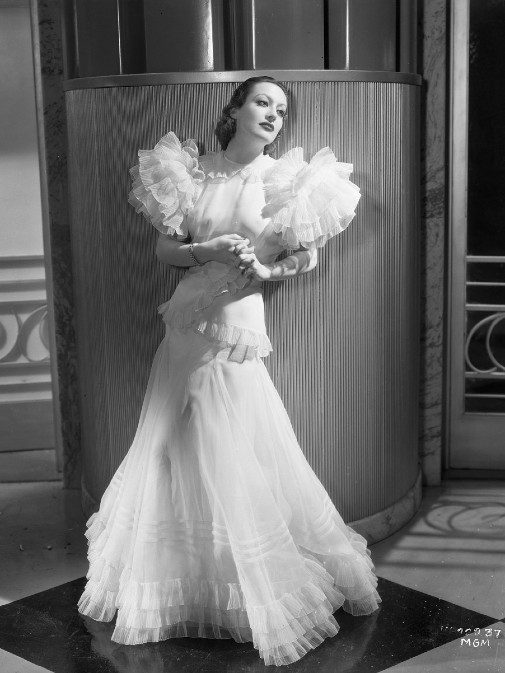 LETTY LYNTON (1932)No working-class person could imagine themselves as the patrician etherealness of Shearer. In contrast, it's easy to see why someone could look at Crawford and see proof that aspirational ambitions aren't bound to fail. Sometimes, triumph is at the end of the hard road of life as the elusive American Dream so duplicitously promises. That's also what Crawford's shining screen presence promised and what she looked for when choosing projects. In her own words, the actress' strategy for picking roles focused on audience identification first and foremost. On-screen, she was thus the self-made survivor and the fallen woman crystalized in celluloid, ready to materialize her fans' escapist dreams. Joan Crawford was also a style icon. Adrian's ruffled organdy dress designed for Letty Lynton is especially famous, having started a small fashion revolution and prompted many copycats that spanned from royalty to the common woman.
LETTY LYNTON (1932)No working-class person could imagine themselves as the patrician etherealness of Shearer. In contrast, it's easy to see why someone could look at Crawford and see proof that aspirational ambitions aren't bound to fail. Sometimes, triumph is at the end of the hard road of life as the elusive American Dream so duplicitously promises. That's also what Crawford's shining screen presence promised and what she looked for when choosing projects. In her own words, the actress' strategy for picking roles focused on audience identification first and foremost. On-screen, she was thus the self-made survivor and the fallen woman crystalized in celluloid, ready to materialize her fans' escapist dreams. Joan Crawford was also a style icon. Adrian's ruffled organdy dress designed for Letty Lynton is especially famous, having started a small fashion revolution and prompted many copycats that spanned from royalty to the common woman.
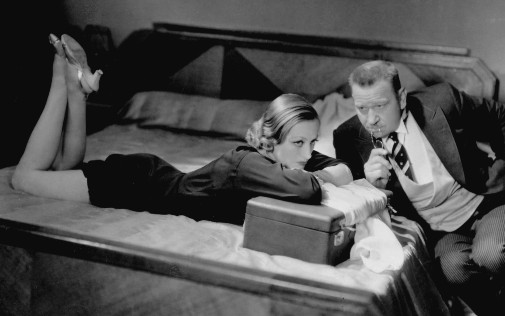 GRAND HOTEL (1932)
GRAND HOTEL (1932)
Considering all this, it may seem strange to see that Crawford didn't score an Oscar nomination until Mildred Pierce. In 1932, she not only starred in a Best Picture winner, Grand Hotel, but wiped the floor with her costar Greta Garbo. I'm a huge fan of that Scandinavian goddess but her depressed ballerina doesn't compare to Crawford's spunky stenographer. Our star considered the flick to be the greatest film she ever made and, while I would disagree with that assessment, it certainly features one of her best turns. She savors every line with shameless pleasure, imbues each gesture with portentous meaning. To explain her snub, we must understand studio campaigning, what was seen as good acting and what publicity could make to a star's perceived prestige.
To be a fashion icon isn't something associated with great acting talent, then or now, and many tend to look down at those who indulge in those "feminine" interests. The same can be said about Crawford's populist appeal, her relatable screen persona, and constant appearance in gossip columns thanks to a myriad of turbulent romances with high-profile actors. Furthermore, the 30s were a time when what was considered good film acting still owed a lot to a theatrical tradition and ideas of transformation. It's no wonder many of the early Best Actress victors were stage sensations before they were Silver Screen Sirens. Crawford was neither a monument of the industry, a living institution, à la Mary Pickford (one of Crawford's mothers-in-law), nor was she a prestige tragedienne of the Broadway stage like Helen Hayes.
When a great actress is also a great celebrity, Hollywood can often take their talents for granted and lose sight of their craft, blinded by the glitz and the apparent simplicity of crowd-pleasing fare. MGM didn't do her any favors either. While their marketing emphasized Crawford as a way to sell tickets, they did not campaign her for awards, preferring to promote other players instead. After being dubiously named box-office poison in 1938, Joan Crawford further saw how her studio gave away the roles she craved to Greer Garson, a new name in their roster. While Crawford kept being saddled with less prestigious material, the other woman got to play great ladies of history, classic literary heroines, and inspirational figures. To this day, AMPAS' loves such roles.
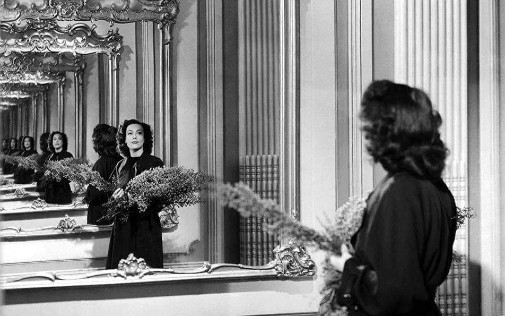 A WOMAN'S FACE (1941)
A WOMAN'S FACE (1941)
All that being said, it's true that Joan Crawford might have earned a nomination in 1939 had she campaigned as a supporting player. Her bitchiness in The Women is insuperable, a queenly show of sharp cattiness that makes deceitfulness look appealing. That film also paired the star with George Cukor, her favorite director and the man responsible for the best of her later films at MGM. While Crawford didn't look with much fondness at the first half of the 40s, what she called her "middle years", I'd point to 1941's A Woman's Face as one of her greatest pictures and what should have been another Oscar nod. Remaking a Swedish Ingrid Bergman flick, Cukor and Crawford composed a study of shattered identity. Once again, beauty and glamour are constructs when played by the actress but, here, they are also jagged and dangerous.
Apart from that exception, I'd agree with Crawford's unhappy feelings towards this part of her career. MGM was simply unequipped and unwilling to perpetuate her stardom. A couple of dreary, if entertaining, World War II-themed oddities, Reunion in France and Above Suspicion, were her last flicks for the studio that had been her home since the mid-1920s. At considerable expense, she bought out her contract and went to Warner Bros. where she demanded greater power in the selection of projects. Her days of acquiescence were over and, for two years, she turned down every role offered. This was risky for her career and her professional longevity, but Crawford also knew what roles were right and what weren't. When she found the perfect part, the actress went as far as doing screen tests to win over director Michael Curtiz. He reportedly preferred Barbara Stanwyck, but Crawford convinced him.
The project was Mildred Pierce, a sanitized adaptation of James M. Cain's novel about an ambitious independent woman living through the Great Depression. Building a restaurant empire, Mildred tries to win the affections of a rebellious daughter through wealth, but ends up betrayed, desperate, with a smoking gun in her hand. I'm not particularly interested in litigating Crawford's domestic life, but it must be said that paired with all the financial and career-focused details of the plot, Mildred Pierce's portrayal of a spiky mother-daughter relationship may have hit close to home. Whatever past trauma or present abuse she might have suffered and inflicted, Crawford channels it all into this woman, her ultimate role, her greatest tour de force.
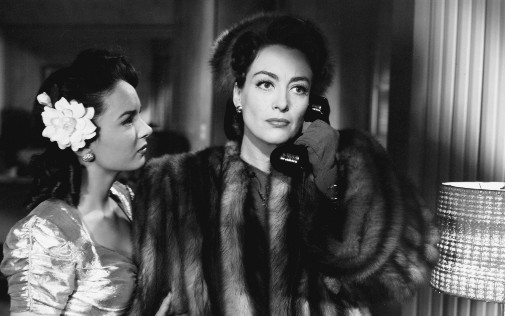 MILDRED PIERCE (1945)
MILDRED PIERCE (1945)
This film noir classic is the culmination of Joan Crawford's life up until that moment. So undeniable is she that an industry that had ignored her for decades finally paid attention. Unlike MGM, Warner Bros. put all its force in guaranteeing Crawford the nomination which also helped. Come Oscar night, she was battling for the trophy with three previous winners – Ingrid Bergman, Greer Garson, Jennifer Jones – as well as Gene Tierney's atypical turn as the psychopathic femme fatale of Leave Her to Heaven. After years of hard work, Crawford finally won and, master of publicity as she was, the actress received her prize at home after a miraculous recovery from a very sudden, very mysterious, illness.
This is a long write-up, one of the longest I've ever done for The Film Experience, and I think Joan Crawford is worth the work. The main reason why this wealth of detail felt necessary is the fact that her troubled legacy tends to overshadow her work, her acting chops, her great movies. The actress' studio switcheroo in 1943 was a ballsy move that signaled a considerate effort to tackle difficult material worthy of her talents. She chose each Warner Bros. movie specifically and made them into some of the most interesting American pictures of the postwar years, maintaining her relevancy well into the 1950s. Joan Crawford is more than a camp joke, she's more than the Gorgon of Mommie Dearest or the tragedy of Feud.
I remember reading a review of Ryan Murphy's exhumation of Crawford's legend where someone implied that Jessica Lange played a scene from Baby Jane with the sort of nuance and skill that were beyond Crawford, always more of a vain star than a good actress. Nearly four years after that show's airing, I still feel outraged about such statements. Why had Joan Crawford's legend, her great filmography, resulted in such a dreadful modern opinion? What can one do to change that? This piece, celebrating the 75th anniversary of her well-deserved Oscar victory, is my attempt at doing that and maybe convince some people to give her a chance. Joan Crawford's filmography is worth your time and one can learn immensities about the history of Hollywood and the Oscars just by watching her movies.
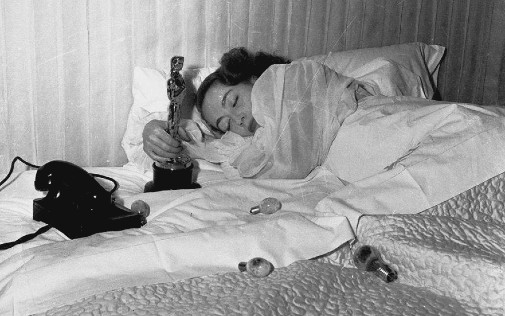



Reader Comments (28)
I don't know if Crawford would have won an Oscar for Grand House even if supporting actress existed as a category. The whole ensemble is great but she does stand out. Her performance is different and very modern. She was doing a different style and sometimes that isn't appreciated until everyone else starts doing it. For example Clift never wins the Oscar but Brando does and is celebrated for a style that Clift was already doing.
I would have given the 1945 BA award to the amazing performance of Gene Tierney in Leave Her To Heaven
This is an amazing write up, and really makes me want to go see a lot of the films you discuss here. She had such raw star power, and I think she expertly used it create memorable characters and moments on screen.
this makes me think about other actresses and actors who, in their prime, failed to get Oscar buzz because they can never took roles that fit the Oscar mold, something that plagued Crawford throughout the 30s. I think of Meg Ryan, a solid actress in lots of rom-coms. It also makes me thinking of Jennifer Lopez, who is no Crawford, but was bested last year by a suffering mother while she played a strong, seemingly confident stripper. I also think her brilliant Karen Sisco was far too contemporary for the costume drama 90s.
Claudio and Crawford, two great flavors that taste great together! It's like the execrable Critics Choice post has made the universe give us nothing but gold posts since. Crazy times we live in!
She was among the top-tier Golden Age screen goddesses: Davis, Hepburn, Crawford (the Queens); Dietrich, Bergman, Garbo (the Europeans); Leigh, de Havilland, Lansbury (the Brits); Garland, Stanwyck, Hayworth (the Extraordinaries).
THANK U for this.
Murphy did her so dirty and Lang was so MISCAST. Gillian Anderson and Virginia Madsen were the two actresses that could possibly pull off a fair depiction of her.
She should've at least 6 noms and 2 wins*
1. Grand Hotel (32, supporting)*
2. A Woman's Face (43, Lead)
3. Mildred Pierce (46, Lead)*
4. Daisy Kenyon (48, Lead)
5. Sudden Fear(53, Lead)
6. Johnny Guitar (55, Lead)
Would be interesting if the Academy hat supporting Categories from the first ceremeony in 1928. What you all think would be the recipients or the deservers in that years? I agree on John Crawford for Grand Hotel in supporting.
Great Article by the Way! Greets from germany.
Joan Great Star Great Actress.
This was a brilliant read,Thanks Claudio.
I think Lange was better in the later part of Joan's life.
Lange was severely miscast, I agree. Sarandon was not, but her acting was half-hearted.
I read a comment where someone suggested Sharon Stone aa Crawford and Judy Davis as Davis. I think that would have been excellent. I also like Lilie's suggestion of Madsden for Crawford.
Carol Burnett did Mildred Pierce much better.
You can vote this race on Twitter. Check @OscarRunnerUp
Wonderful write-up!
I agree that Joanie is underappreciated, that hatchet job Christina did on her was very thorough destroying decades of hard work in a couple of weeks and has lasted ever since.
She was capable of great depth if the character was suited to her skill set which is why some of her attempts at variety, Rain and especially The Gorgeous Hussy in her Metro days were disasters. As you said she was always RIGHT NOW in terms style and attitude which made her the most contemporary of actresses but completely out of place in period pieces.
I've seen almost all of her extant films, several of her silents were lost in the 1964 MGM vault fire, having only four of those early silents to still track down and it's fascinating to watch her evolve from the garish flapper to the ambitious but hard luck working girl to something more sophisticated but brittle in those MGM years.
Watching Grand Hotel now she remains refreshingly contemporary in her attitude where others style has became more prosaic. If the category had existed and either she or the studio had allowed her name to be submitted in supporting (which almost immediately upon its creation became a mark that a star had passed her peak period if she allowed herself to be slotted there) she would have stood a good chance of winning.
There is a promotional short simply called "1925 Studio Tour" that was designed to show MGM as one big happy family. When the camera is scanning through the throng of contract players it alights on to quote "Lucille Le Sueur-a 1925 find!" she's nearly unrecognizable-a terribly unbecoming marcelled hairdo, far too much makeup and an ugly dress but then she smiles and right before your eyes the Joan Crawford of future years shines through.
She's not my favorite actress, but she was very good, specially after Mildred Pierce (1945), before that movie I like Rain (1932).
She was a very interesting star. I loved her. Although I only saw movies from the 1950s on, I still loved the quality of her acting ... not the
Greatness.
I have read 2 bios of her and she was quite a dame!!!
Had the Supporting Actress award been around in 1932, the year offered a bumper crop of deserving performances in the category.
Anyone interested should check out
Mary Astor "Red Dust"
Mae West "Night After Night"
Alison Skipworth "Night After Night"
Louise Closser Hale "Shanghai Express'
Frances Dee "Love is a Racket"
Thelma Todd "This is the Night"
I agree that Crawford is very good in "Grand Hotel" but I'd have nominated her as part of the 1932 Best Actress field for Lewis Milestone's "Rain". It's a marvelous film and - as Sadie Thompson - Crawford (on loan-out from MGM to another studio) has lots of terrific moments. Unfortunately, the film was a box office flop and - with her instincts permanently attuned to what the public wanted - the actress tended to dismiss the picture ever after.
I like Grand Hotel a lot, and there's no denying everything pops a little more when she's onscreen.
I was a big fan of her in Strange Cargo. The story's a bit cheesy, but Crawford did some strong work. Plus trudging around the jungle in a dress and heels surely can't be easy.
One of the things this doesn't really mention is her great strength and frequent casting as the main actress opposite the big male movie stars, specifically Gable. I think this helped her in her career, but not so much in her acting legacy since the films were usually not "her" films but rather his.
And I agree that A Woman's Face is my favorite MGM movie of hers. And I am pleased that she won her Oscar for her best role in her best movie. How often does that happen really?
@Dave in Hollywood So true!
Another who fits that mold is Vivien Leigh in Gone With The Wind and A Streetcar Named Desire- best two time winner in this category ever?
Are there any others who won for their best role(s) in their best film(s)?
It took a while, but I've grown to respect Crawford as an actress. In the early years of talkies, she did some really great work (Rain, Grand Hotel, Dance Fools Dance). But as the Thirties progressed, she settled into an uninspired pattern of similar vehicles as the shop girl torn between the rich guy who can give her the world and the poorer guy who is really the better man.
A Woman's Face should have gotten her a nomination in 1941. She was far better than Fontaine or Garson. The move to Warners was the shake-up she needed. Mildred Pierce is a truly great film, and the rest of her films at the studio are tailored to her talent. I have a soft spot for Flamingo Road. It's too much fun watching her go up against Sidney Greenstreet.
Her Fifties and Sixties films aren't great but they're rarely dull and her work in Baby Jane, although not as flamboyant as Davis, is underrated.
Like the biggest stars, she was undoubtedly very complicated. But she had that extra level of star power that sets a few apart from others.
Ken -- totally agree on RAIN. Really love her in that picture.
GRAND HOTEL. Thats the one I would have handed her the Oscar for no question. She summons up a totally underwritten role purely through mood and tone. It’s both a typical and atypical performance in that all of her star wattage is totally on display, yet without any overheated melodramatics or straining to compensate for limitations. She’s dynamite in that movie.
Definitely should have one, at least among that roster, for Mildred Pierce. Certainly should have been nominated for a woman’s face, and I would have swapped out Possession for Daisy Kenyon. But I also love her in Possession. Actually all three of her nominations are among her best work.
Peter, it's "Possessed." She should have received nom for "Humoresque."
Peter -- me too. Absolutely win worthy in GRAND HOTEL. But if it were up to me she would have two because no way am I taking that Mildred Pierce Oscar away.
“I remember reading a review of Ryan Murphy's exhumation of Crawford's legend where someone implied that Jessica Lange played a scene from Baby Jane with the sort of nuance and skill that were beyond Crawford, always more of a vain star than a good actress. Nearly four years after that show's airing, I still feel outraged about such statements. Why had Joan Crawford's legend, her great filmography, resulted in such a dreadful modern opinion?”
@Claudio, It is a well-known fact tt Crawford prides herself as a STAR first and an actress second. She herself carefully cultivates and perpetuates this larger than life, glamourous façade (not unlike Dietrich), and this “maternal” mommy image (which Mommie Dearest quite aptly captures). In the end, she turns herself into this phony person tt even she couldn’t recognise anymore (captures quite poignantly by Lange in the last eps of Feud)
Sure, she has real talents and she is miles complicated than Faye Dunaway’s portrayal, but I dun tink she can be excused from blame on the modern perception of her, since she perpetuates and even encourages some of the myths around her.
The key difference between Bette and Joan is tt the former has enormous self-confidence, whether she is good in the picture or not, while Joan lacks the confidence and is constantly seeking acceptance and pulling all the tricks to stay in the limelight.
I'm really glad you pinpointed Grand Hotel, The Women and A Woman's Face. These are three of my absolute favourite Crawford movies and performances, easily as good (if not better) than nominated early work from Hepburn and Davis. I also felt she was snubbed for other films post Oscar win: Humoresque, Harriet Craig, Johnny Guitar, The Story of Esther Costello and, of course, Whatever Happened to Baby Jane?
It's a sad shame that her incredible career has long been overshadowed by the abuse allegations. I'm pleased that Ryan Murphy's show at least made younger film fans think twice about Joan. And even though I thought Lange was badly miscast (she's far better suited to Bette Davis, whereas Sigourney Weaver would have made a sublime Crawford) she did Joan justice.
Happy for all this love for Crawford.
A talented and charismatic actress largely recognized for her professionalism, she was one of the main stars of the era of big studios and was paired with big leading men: Clark Gable (8 movies in MGM), John Wayne, Spencer Tracy, John Garfield, Gary Cooper, etc. However, it's with other leading ladies her most memorable moments: The Women, What Ever Happened to Baby Jane ?, Mildred Pierce, Johnny Guitar.
Two recommendations among lesser-known films in Joan's filmography:
Possessed(1947) Homonymous to another film of the actress of 1931 of her Metro times. This one's from her contract with Warner post-Mildred Pierce and gave her the second of her three Oscar nominations. Perfect mix of melodrama, psychological drama and film noir where she is an emotionally unstable woman and she declared that the part was the most difficult she ever played.
When Ladies Meet(1941) The big thing here is the meeting of two stars, Crawford and Greer Garson, at different times in their careers, in their only film together. While the former is in her last moments as one of the queens of MGM(she would make three more films for them), the latter is just moments away from becoming the absolute queen of MGM. Dramatic romantic comedy remake of a 1933 film about a novelist in love with her married publisher. Guess who plays the role of the homewrecker?
I'm also a Crawford fan. I know a little bit about this person. But I will research a lot in my free time because now I am highly interested to know about this person. Anyway, I am a little bit coufused about my husband's behaviour. I want to track him and started looking for a good app like Click here for tracking your husband's texts. I hope from now on I can monitor everything I want especially my husband.